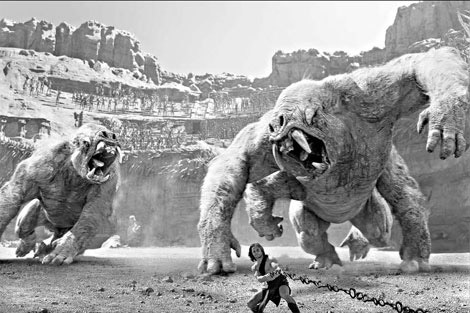
 |
|
The film "John Carter" cost an estimated $350 million to make and market but had a poor opening this month. Walt Disney Pictures |
LOS ANGELES - In 1987, shortly before the release of "Ishtar," Columbia Pictures realized the film was going to flop in catastrophic fashion. But rather than cut advertising spending to minimize the financial damage - as the studio's top marketer advised - Columbia did the opposite, pouring even more money into ads.
The reason? The studio was desperate to stay on good terms with the two stars of "Ishtar," Warren Beatty and Dustin Hoffman. "Ego trumps logic in Hollywood," said Peter Sealey, who was Columbia's marketing chief at the time.
Another example is "John Carter," a big-budget science fiction epic from Walt Disney Studios that opened in mid-March and flopped. Disney spent lavishly on the movie in large part to appease one of its most important creative talents: Andrew Stanton, the Pixar-based director of the mega-hits "Finding Nemo" and "Wall-E."
"John Carter," which cost an estimated $350 million to make and market, and was directed by Mr. Stanton, took in about $30.6 million at the North American box office its first weekend, a figure well below what is needed to justify its blockbuster budget.
That result was so poor that Disney was forced to take a quarterly write-down of $200 million on March 19. The larger-than-expected total reflects poor global reaction to the film after two weekends in theaters; sales total about $184 million, which must be split with theater owners.
Profitability for "John Carter" was always a challenge. Because of its enormous cost and the way ticket sales are split with theaters, analysts say the film needs to take in more than $600 million to break even.
Rich Ross, chairman of Walt Disney Studios, said in a statement, "Moviemaking does not come without risk. It's still an art, not a science, and there is no proven formula for success. Andrew Stanton is an incredibly talented and successful filmmaker who with his team put their hard work and vision into the making of 'John Carter.' Unfortunately, it failed to connect with audiences as much as we had all hoped."
There were red flags from the beginning. Mr. Stanton had never directed a live-action movie before. He wanted to cast no-name actors. And the screenplay, based on a story by Edgar Rice Burroughs that was serialized in 1912 and later published in book form as "A Princess of Mars," was a bewildering mash-up, starting during the Civil War and moving to the Old West before leaping to a planet called Barsoom (Mars), home to tusked, four-armed creatures called Tharks.
But Mr. Stanton passionately lobbied to make the movie, and there was a compelling argument to say yes. Mr. Stanton, whose writing credits include "Monsters, Inc." and all three "Toy Story" movies, had a strong record with difficult material. People were skeptical about "Wall-E," about a computer that does not talk, but Mr. Stanton turned it into a blockbuster with more than $521 million in global ticket sales. "Finding Nemo" took in $868 million. Both won Oscars.
Accustomed to reworking scenes over and over at Pixar, Mr. Stanton did not take well to the usual constraints of live-action - succeeding the first time - and went back for at least two lengthy reshoots.
"The thing I had to explain to Disney was, 'You're asking a guy who's only known how to do it this way to suddenly do it with one reshoot,'" he told The Los Angeles Times. "I said, 'I'm not gonna get it right the first time. I'll tell you that right now.'"
By the time "John Carter" had its Los Angeles premiere last month, the film had suffered months of ridicule on the Internet and had taken on a funereal aura. "I've never had something healthy get treated like a corpse," Mr. Ross told Variety.
Reviews were not as blistering as some had expected, but they were not good, with critics calling the film a hectic hybrid of other movies: "Avatar" meets "Star Wars" meets "Gladiator" meets "Prince of Persia" meets any of John Ford's westerns.
If Mr. Stanton has any comfort, it may be that he keeps good company. Baz Luhrmann is there for "Australia," along with George Lucas for "Howard the Duck" and Michael Cimino for "Heaven's Gate." And, of course, Mr. Hoffman and Mr. Beatty for "Ishtar."
David Allen is chairman and founder of the David Allen Company, a productivity consulting and training company. He is also the author of "Getting Things Done."